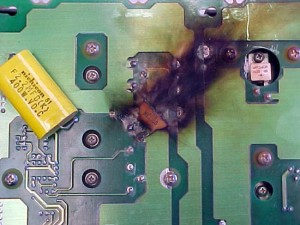Always remember the Electronic Axis of Evil: Moisture, Heat, and Dirt. If you can avoid these, your circuit boards will last longer.
Four Top Reasons For Circuit Board Failure and Tips to Identify The Problems & Causes:
1. Discrete Component Failure. (Includes capacitors, resistors, zener diodes, diodes, GALs, PALs, IC’s, Microprocessors, Driver Chips) Causes of failure: normal component aging, excessive heat, over or under voltage surges and sags, rises in ESR (equivalent series resistance) values, corrosion and drying (esp. of electrolytic capacitors). These problems can sometimes be visible to the naked eye such as blown/burned components or obvious corrosion, but usually these items need to be checked with meters.
2. Power Component Failure. (Includes transformers, transistors, IGBT modules, rectifiers). Causes of failure: heat, over or under voltage, normal component aging. Some problems can be visible such as exploded components, or, more often, they could look perfectly good and require meter testing of each component.
3. Trace Damage. (These are the conductive pathways, tracks or signal traces etched from copper/silver coated sheets and laminated onto the non-conductive substrate) Causes of failure: power surges, lightning strikes, use of inappropriate acid core solder causing shorts, contamination such as metallic dust. Trace damage is often visible to the naked eye and can often, though not always, be repaired.
4. Physical damage – This is plain, old damage such as when your NASCAR-wannabe forklift driver skewers it like a sausage on a grill. Don’t think it doesn’t happen…we’ve seen it! This is sometimes repairable; replacement is often the only option.
Repairing printed circuit boards can be a bit like surgery: lots of testing, probing and prepping followed by precise repair work and retesting before the patient is ready to go back to work. The good news is, your board is most likely repairable.

